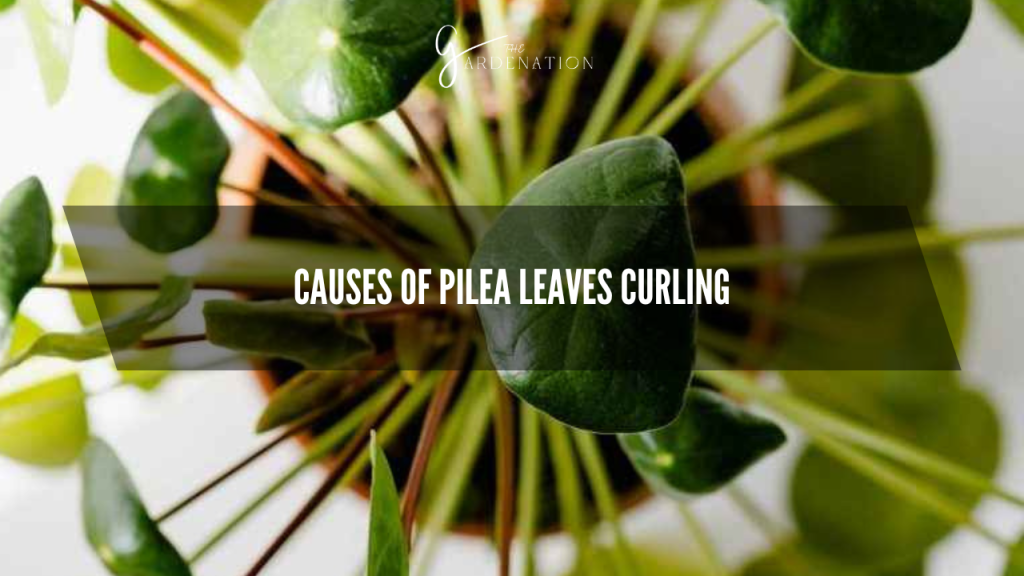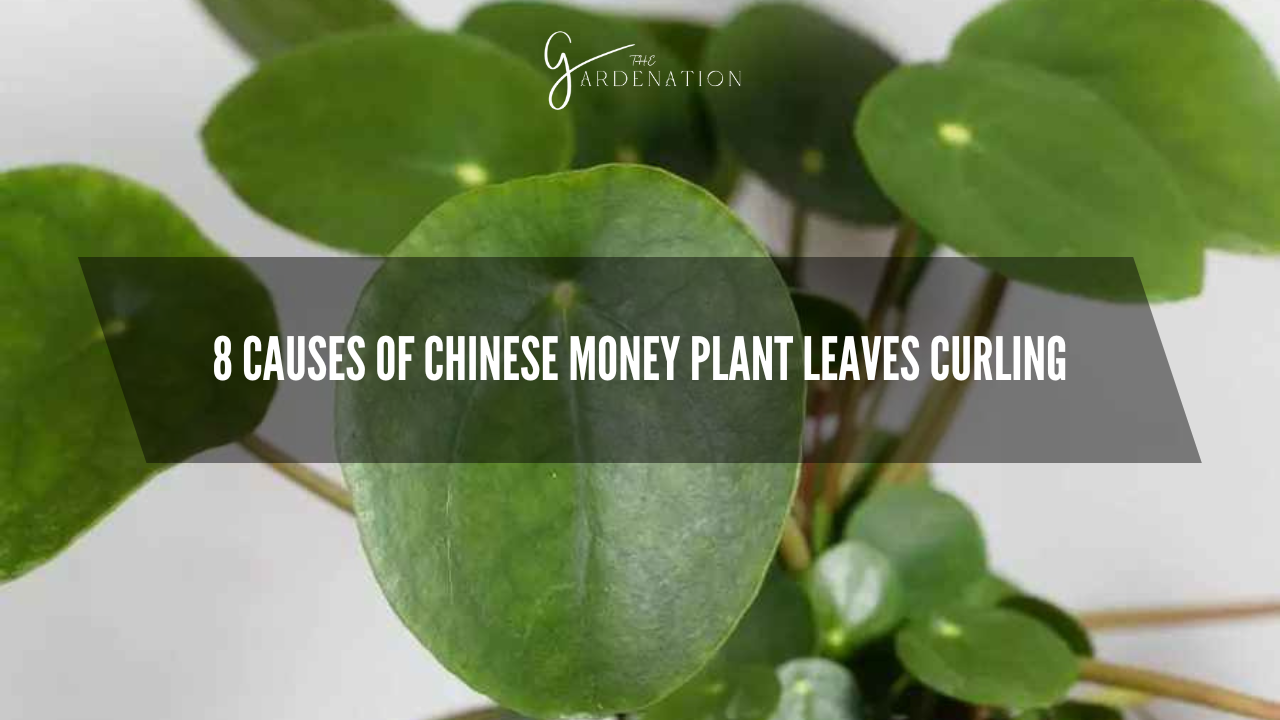8 Causes Of Chinese Money Plant Leaves Curling
The Chinese money plant, also known as the UFO plant, coin plant, or pancake plant, is easily recognized by its distinctive round, flat leaves. While Pilea peperomioides is relatively easy to grow as a houseplant, Chinese money plant leaves curling are a common issue that I seek to troubleshoot.
When stressed, Pilea foliage will respond by curling either downwards (doming) or upwards (cupping). Identifying whether new growth is doming or cupping is key to diagnosing the underlying cause and resolving the problem. I have explored the eight most common reasons for curled Pilea leaves, explained how to differentiate symptoms, and offered solutions to get your plant back to health.
Causes of Pilea Leaves Curling

Leaf curling indicates that something is stressing your Pilea. The foliage reacts by growing in an abnormal shape in an effort to protect the plant. Curling can take two forms:
Doming – Leaves curve downwards, with the center higher than the edges. This intensified arching happens when the plant is desperately seeking more light exposure.
Cupping – Leaves curve upwards, resembling the shape of a cup or bowl. This occurs in response to too much light, heat stress, or impaired root function.
When new leaves emerge, I pay attention to their shape and growth patterns. This reveals whether doming or cupping is occurring so you can accurately diagnose the cause.
Identifying Symptoms & Fixes
I don’t get alarmed if newly emerged leaves show some initial curling because the foliage will naturally flatten itself out as it matures. But if curling persists or appears in older leaves, the I look for any underlying issue.
Here are common reasons for chinese money plant leaves curling and tips to resolve them:
1. Overwatering

Leaves severely dome downwards. Lower foliage turns yellow or brown and drops. Signs of root rot may occur.
Solution: I allow soil to partially dry between waterings. I water less frequently. I ensure the pot has drainage holes. I sometimes consider repotting to dry out saturated roots.
For more information about kitchen garden you can visit: Companion Plants For Ginger
2. Underwatering

Leaves cup upwards. Foliage appears limp, wrinkled or shriveled. Growth slows.
Solution: I water when the top inch of soil is dry. I increase watering frequency.
3. Poor Soil Drainage

Leaves severely dome as if overwatered. Soil stays wet for a prolonged time after watering.
Solution: I repot in a container with drainage holes, using a well-aerated potting mix. I allow soil to partially dry out between waterings.
4. Dim Light

Leaves dome, attempting to increase light exposure. Leggy growth with sparse leaf sets.
Solution: I provide bright, indirect light. I supplement with grow lights if natural light is insufficient. I rotate the plant periodically for even exposure.
5. Low Humidity

Leaf margins and tips turn brown. Foliage appears dried out. Cupping may occur.
Solution: I mist plant regularly or use a pebble tray. I run a humidifier nearby. I group plants together to raise local humidity.
6. Temperature Stress
Leaves cup or wrinkle in intense heat or cold drafts. Plant appears stressed.
Solution: I keep Pilea in the optimal 60-80°F temperature range. I move plants away from heat/AC vents and drafts.
7. An Outgrown Pot or Container
Lower leaves yellow and drop as roots compete for space. Drainage suffers. Stunted growth.
Solution: I repot in the next sized pot, no more than 2 inches larger. I use a fast-draining soil mix. I handle roots gently.
8. Physical Damage
Tears, holes, or bruises on foliage. Affected leaves curl.
Solution: I prune damaged leaves. I try to be gentle when handling plants to prevent injury. I keep pets away.
Overwatering
Overwatering deserves special attention since saturated soil is the most common reason of chinese money plant leaves curling. Too much moisture suffocates the roots, leading to rot and impaired nutrient/water uptake.
Signs of Overwatering
- Severely domed, drooping leaves
- Yellow or brown lower leaves
- Leaf drop
- Dark, mushy roots
- Foul odor from the soil
Consequences
Without intervention, complications cascade. Rot spreads to healthy roots, destroying the plant’s ability to absorb moisture and nutrients. Foliage yellows from nitrogen deficiencies and eventually defoliates. Untreated root rot leads to declining health and potential death of the plant.
Proper Watering
Pilea prefers a moist but not wet soil environment. I allow the top inch of soil to dry out between waterings. Then, I soak the soil completely until water drains from the bottom drainage holes.
The watering frequency will vary based on factors like sunlight, temperature, humidity, container size, and soil composition. I try to understand my plant’s needs by observing it regularly. I adjust my watering routine based on the foliage and soil moisture cues.
Well-Draining Soil
I amend regular potting mix with perlite, orchid bark, coco coir, or horticultural charcoal to create the fast-draining soil Pileas require. This light, airy composition prevents moisture from pooling at the roots. Approximately 20-30% amendments to regular potting soil is ideal.
If overwatering issues persist in an appropriate potting medium, the excess moisture is likely due to watering too frequently for your environment and becomes the reason of chinese money plant leaves curling.
Right Light Conditions
While Pilea enjoys bright light, it should never sit in direct sun which can scorch the foliage. Insufficient illumination is another trigger for lasting leaf curl as the plant attempts to broaden its surface area to absorb more light.
Ideal Light
I place my Pilea in a spot with medium to bright, indirect sunlight for 4-6 hours daily. East or west-facing windows are perfect. I rotate the plant periodically for even exposure. Leaves may angle themselves toward the light—this natural movement, called phototropism, ensures optimal photosynthesis.
If my home lacks sufficient natural light, supplement with full spectrum grow lights. I position the lamps 12-18 inches above the plant for 14-16 hours daily. Timer systems automate this lighting schedule. I dial back the duration during the shorter days of winter.
I monitor my Pilea’s light conditions by observing the foliage health and directionality. I prevent scorching but satisfy its craving for bright, indirect light. This encourages lush, vibrant growth with flat, evenly spaced leaves.
Managing Humidity & Temperature For chinese money plant leaves curling
Humidity and temperature extremes also trigger Pilea leaf issues. Dry air causes leaf tips and margins to brown. Heat or cold stress leads to cupped, wrinkled, or curled leaves.
Ideal Humidity Range
Pilea thrives in 40-60% relative humidity. In dry indoor environments, I use a humidifier to raise moisture levels. I group plants together to create a localized humid microclimate. I place containers on pebble trays filled with water, making sure plants do not sit directly in water. I try misting plants to provide a temporary humidity boost but risks promoting fungal diseases if moisture lingers on foliage.
Ideal Temperature Range
I maintain household temperatures between 60-80°F. Pilea cannot tolerate cold drafts or heating vents. Hot sun shining directly on leaves can also overheat plants.
I monitor conditions with a thermometer/hygrometer and adjust as needed. I keep Pilea away from cold windows in winter and hot windows in summer. I open blinds to release excess heat on hot days. I close blinds or curtains at night to conserve warmth.
Vigilant humidity and temperature control prevents stress responses like cupped, curled leaves. Healthy Pileas can withstand minor environmental fluctuations but aim to provide as much consistency as possible.
Repotting and Container Considerations
As Pilea matures, it may outgrow its pot. Root crowding leads to stunted growth, leaf yellowing and drop. Poor drainage often accompanies a too-small container.
When to Repot
Roots are visible at the drainage holes or surface of the soil.
Lower leaves rapidly yellow and drop.
Soil dries out very quickly between waterings.
I notice reduced growth.
Repotting Tips
I repot in early spring before growth takes off. I choose a container only 1-2 inches wider than the current pot. Anything much larger retains too much moisture.
I handle roots very gently when repotting to avoid damage. I use fast-draining soil amended with perlite, orchid bark, or charcoal. I firm the mix gently around the roots and water well to settle soil.
Avoid Rootbound Conditions
Ideally I repot Pilea before it becomes severely rootbound. I try gentle yearly repotting which maintains vigor better than allowing plants to overly outgrow their containers. This prevents leaf curling issues tied to poor drainage, stunted growth, and nutritional deficiencies.
Dealing with Physical Damage
Direct injury to Pilea’s foliage can also create leaf curling. Solutions involve preventing and managing such damage.
Causes of Physical Damage
- Pets or children brushing against the foliage
- Leaves snapping off when brushing against other plants
- Accidental bumps and scrapes during plant handling
- Insect infestations leading to chewed foliage
Preventing Damage
- I place Pilea out of high traffic zones
- I take and tie plants if needed to prevent jostling
- I keep indoor plants isolated from potential pests
- I handle gently during plant maintenance
Pruning Damaged Leaves
I remove badly damaged leaves cleanly with sterilized scissors. I make cuts just above leaf nodes rather than tearing leaves off. Damaged tissue is vulnerable to bacterial/fungal infection which can spread.
Pruning stimulates branching from leaf nodes, allowing you to propagate new Pileas. I root the cuttings in water or potting mix to grow an entirely new plant!
Frequently Asked Questions
Is it normal for new Pilea leaves to curl?
Yes! Newly emerging leaves often curl around themselves while expanding and flatten out as they mature. Unless curling persists long-term, this indicates normal growth.
My Pilea is actively growing but some leaves are slightly cupped. Should I be concerned?
As long as most foliage appears healthy, some slight cupping is not necessarily problematic. Monitor for other symptoms of underwatering like wrinkled or limp leaves. If unsure, increase water slightly and see if cupping resolves over the next few weeks as new leaves emerge.
I addressed the cause but existing curled leaves have not flattened out. Will they return to normal?
Unfortunately, leaves already deformed from long-term stress typically do not regain their original shape. But the good news is that new, healthy foliage will emerge once environmental issues are corrected. Focus on the new growth!
Conclusion
By understanding the various causes of lasting Pilea leaf curl, you can identify deficiencies and remedy issues before they escalate. Attentive care will reward you with a vibrant, ever-expanding Chinese money plant. Appreciate both the process of troubleshooting challenges and the satisfaction of nurturing a thriving Pilea over time.


2 Comments